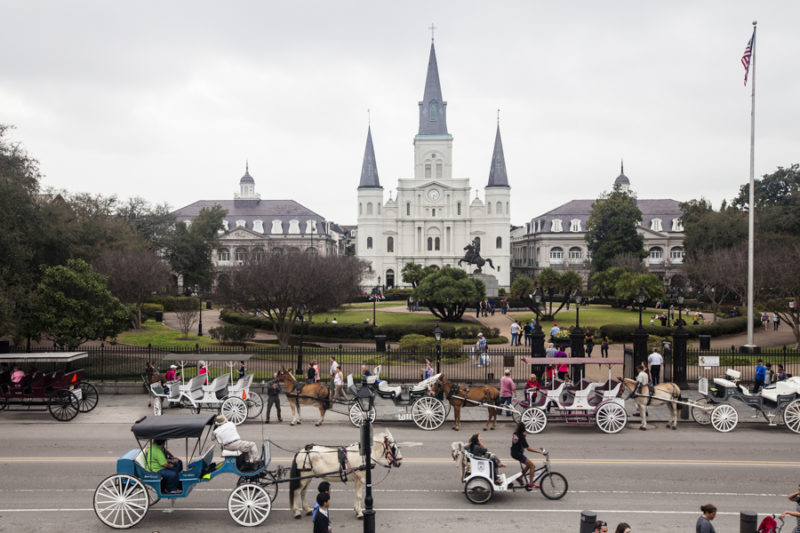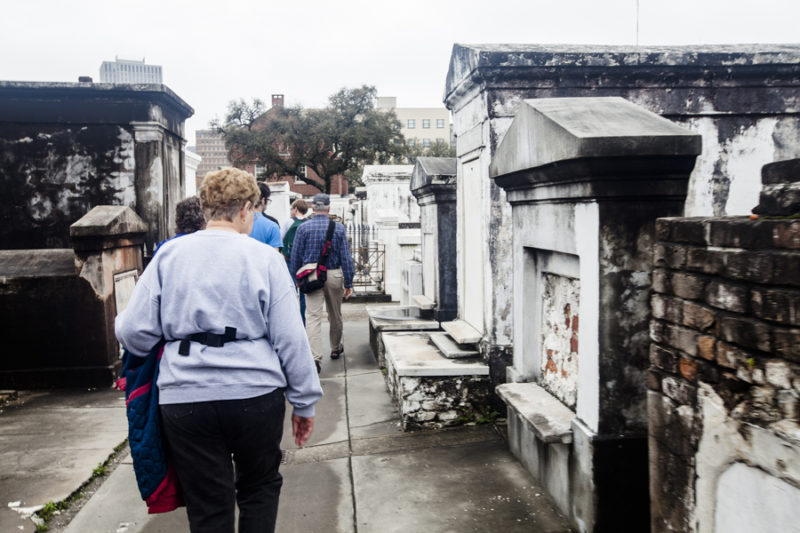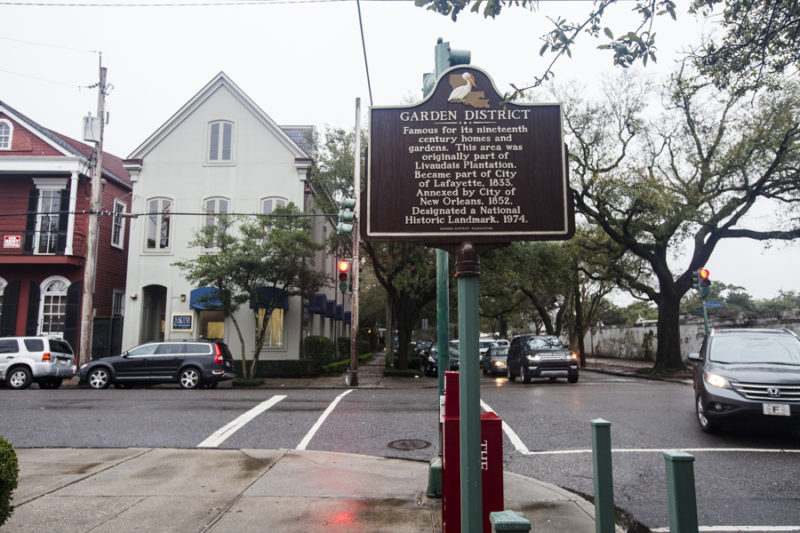
Some of Miller’s many competitors line the streets in front of Jackson Square. Photo by Erin Mahoney
After a long day on her feet showing tourists around the city, Christine Miller is excited to go home, kick off her shoes and rest her legs and voice before leading more tours the next morning. Thankfully, her first tour the next day is at 10:00am and meets only a few blocks from her house uptown, so she has time to rest and spend time with her dogs. Christine’s work does not have a set location or shared workspace, which is common of new work and creative work which is, “is now mediated by a new rhetoric of mobility and success” (Angela McRobbie. Cultural Economy. “From Holloway to Hollywood: happiness at work in the new cultural economy?” 101. Print).
As she sits down, her eyes wander to a pile of paperwork that she has yet to fill out, which seems to be constantly growing. The pile includes superfluous bills including those for living expenses, health insurance, and tour guide permit fees. Unlike some of the other tour guides who work for larger companies, Christine does not have employment benefits as she is self employed. Lack of employment benefits like health insurance is common of creative workers and new work which means, “risk work where social responsibility for working lives is offloaded onto the individual,” leaving workers to, “pick up the costs which in the past were covered by the employer.” (McRobbie). In addition, tour guide permits cost $50 and must be renewed every two years for $20, along with bank statements and letters from her family in Florida (“Tour Guide Permit.” The City of New Orleans. 11 May 2015. Web. 4 Nov. 2015).
Christine digs into the pile and reminds herself that the mountains of paperwork and bills that come with being self employed by her own tour guide company. Christine became a tour guide in 2012 and started her own company in 2013. She opened her business at the same time that many other start-ups were opening. “From 2009-2012, the start up rate exceeded the national rate by 56%” making New Orleans, “a fertile environment for an entrepreneurial culture” (Mitchell Landrieu. 2014 New Orleans Cultural Economy Snapshot. 2014. 11. Print.) Two Chicks Walking Tours is worth it; otherwise she would make much less. Christine charges $29 per person for a public tour and $395 for a private tour. In Louisiana, tour guides make an average of $12.95 per hour and work more than double the hours that she currently does (“Occupational Employment and Wages.” U.S. Bureau of Labor Statistics, 25 Mar. 2015. Web. 4 Nov. 2015). Christine does one to three tours on any given day, each lasting for about an hour. Tour guides who are a part of larger companies can be expected to work from 10-18 hours a day. “Day in the Life of a Tour Guide.” (WikiEducator. 4 Feb. 2014. Web. 4 Nov. 2015).
“The Internet levels the playing field for people just starting out.”
Christine puts aside her paperwork and lets her dogs outside before going to sleep. She opens her computer to check if anyone from her tours that day had posted reviews for Two Chicks Walking Tours on Yelp or Tripadvisor. These reviews are an example of how people are no longer separated into producers and consumers. People writing reviews have bought Christine’s tour guide services which makes them consumers. They then produce content online on sites such as Yelp and Tripadvisor, which will be received by other potential customers of Christine (Laikwan Pang. Creativity and Its Discontents. “Creativity as a Construct of Rights.” Duke UP, 2012. Print).
She is excited and relieved to see a few new glowing remarks from her customers; after all, these stellar reviews are her only form of advertising. She relies on her knack for storytelling and connecting with her audience to get reviews to make her company popular and profitable. These reviews are a concrete way to determine how well Christine and her company are doing. “In craftsmanship we are able to judge how well someone performs by looking at the concrete results of their labors.” (Richard Sennett. The Culture of the New Capitalism. New Haven: Yale UP, 2006. 114. Print). Thankfully, she had plenty of practice telling stories to her five younger siblings growing up, so storytelling on her tours come naturally. Christine has developed a talent that she uses in her field of work. Succeeding in creative work demands a great deal of talent.
She recognizes that “when you’re able to connect and engage someone with stories and make them look around, it’s really rewarding,” and says that New Orleans “makes a lot more sense once it’s explained to you and someone takes you by the hand and shows you around.” As she looks at the many reviews, Christine remembers what it was like before her company had these endorsements, when she was just starting out.
Even though she will be on her feet all day, Christine is never as exhausted as she was when she began working as a tour guide.
In the morning, Christine walks a few blocks from her house to District Donuts and Sliders on Magazine Street, where she will meet her first tour of the day. While she is tired from staying up late with paperwork, she is much more rested than when she worked multiple jobs in order to pay the bills. Working multiple jobs is common of creative workers in the new work environment where unemployment benefits are not available in these lines of work, “the only alternative is to stack up other jobs until more fulfilling opportunities arrive” (McRobbie). Christine went to tour guide school and stayed up late studying for her tour guide exam after completing an eight-week program at Delgado Community College. These programs are not required of a tour guide, but many go through the process as it offers better preparation for life in the industry. The final exam at the school is equivalent to the tour guide exam that everyone has to take in order to get a permit, which tests potential guides on their knowledge on the history and culture of the city. She remembers feeling relieved after passing her exam, only to find that she had to buy herself a drug test and wait for a background check before getting her license. When she finally got her license, she continued working multiple jobs while giving tours. She was just as exhausted as before. Similar to Christine, it is common for workers in the cultural sector to exploit themselves by working hours that could not be legally enforced by an employer (McRobbie). Many lay awake at night, wondering when their company will start to turn a profit. In discussing entrepreneurship, “it has often been said that while any fool can have a good idea, only a few great minds have it in them to start a profitable business.” ( Alain De Botton. The Pleasures and Sorrows of Work. “Entrepreneurship.” 281. Print). It hasn’t been easy. Christine remembers the excitement when she launched her website and the worry when she barely had any customers, only to realize weeks later that the website didn’t work on cell phones. She recalls questioning her decision to give up the security that she had while working at the World War II Museum, but constantly told herself that it would be worth being her own boss someday. Through trials and tribulations though, success is possible. Christine is independently employed, she is able to make her own hours, determine her own prices, give the tours that she chooses and tell the stories of the city in any manner that she desires. This type of freedom in her work brings Christine and many other creative workers occupational prestige which is, “equated with self-direction and autonomy more than with money or power” (Sennett).
“[The tour guide industry] is extremely important to the culture of New Orleans. People really appreciate how unique the city is.”

A view from the back of Miller’s tour. Photo by Eric Mahoney
Glad that she convinced herself to take these risks a few years ago, Christine heads downtown where she will lead the rest of her tours that day. She inhales the familiar smell of beignets as she makes her way past the long line of tourists waiting to enter Café Du Monde. She meets her group and begins the French Quarter stroll tour, leading the wide-eyed tourists away from the beignets and into the heart of the French Quarter. As she tells them stories of the unique history and culture within each block of the city, she realizes that her success as a tour guide would only be possible in a city like New Orleans where tourism flourishes. In 2013, the tourism industry welcomed 9.28 million visitors who spent about $6.5 billion, which is a 4.5 percent increase from the year before (“New Orleans Achieves 9.28 Million Visitors in 2013.” The City of New Orleans. 22 Apr. 2014. Web. 4 Nov. 2015). “Part of the contributing reason to being able to support myself is that new Orleans is a mega destination for so many different reasons”, she reflects. “We’re America’s most unique city.” “City of culture initiatives” and city branding strategies “seek to find or impose uniqueness,” upon a city through marketing by selling heritage (Andy C. Pratt.“The Cultural Contradictions Of The Creative City.” City, Culture and Society: 124-125. Print). These branding strategies are extremely present in New Orleans, as it is often thought of as one of the most unique cities in America. New Orleans makes a point to capitalize upon this perception of uniqueness which is shown by the booming tourism industry. Christine’s company is one of many that benefits from how the city has been branded.
Across the street is a guide from a different company in the middle of giving a tour. Christine smiles and waves at him, always, “happy to see other tour guides doing well.” She knows that the abundance of visitors who come to New Orleans wanting the experience of a tour ensures that there are enough customers for both of them. According to the Hollywood organizational model, cultural industries, “commodify, package, and market experiences as opposed to physical products or services,” and seek to “[commodify] experience itself.” Tourism is one such cultural industry that sells experiences instead of material goods, by selling the culture of the city to visitors. (Jeremy Rifkin. The Age of Access: The New Culture of Hypercapitalism, Where All of Life Is a Paid-for Experience. New York: J.P. Tarcher/Putnam, 2000. 365. Print).
“I knew right away it was my happy place. I knew where I wanted to make a life for myself- it was New Orleans.”

The picturesque Garden District is a common tour stop. Photo by Eric Mahoney
Christine confidently leads groups through the city that was once unfamiliar and mystical to her. When Christine came here in 1985 to attend Loyola University, she knew no one and knew nothing about the city. Now, she sees the familiar faces of street musicians, says hello to her friend coming out of his shop where he makes gas lamps, and tells stories about the city that she has become so familiar with to visitors that remind her of herself when she first moved to New Orleans.







